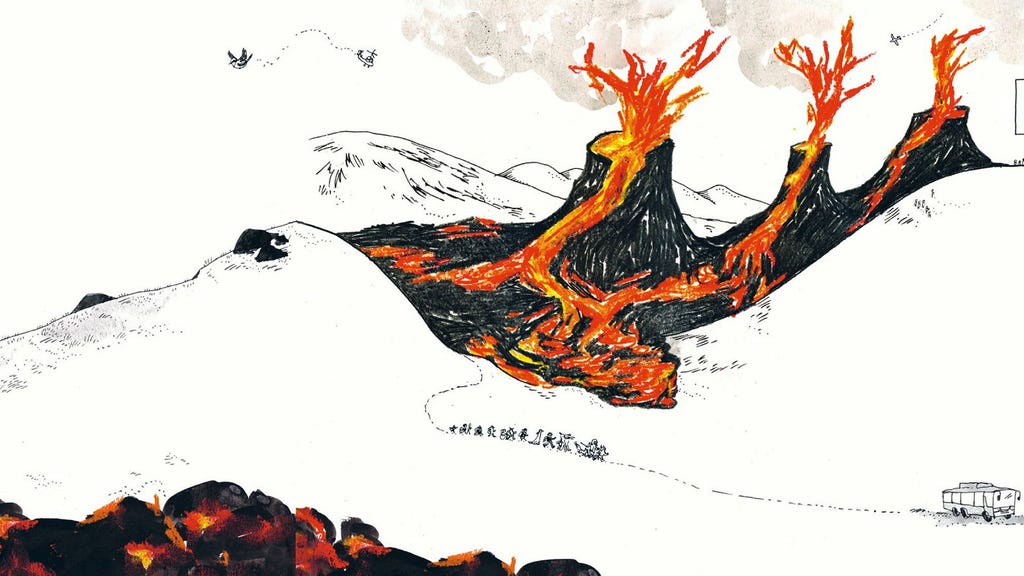Rán Flygenring’s ”Vulkanen,” winner of the Nordic Council Children and Youth Literature Prize, is a genre-bending graphic novel inspired by recent volcanic eruptions in Iceland’s Reykjanes peninsula. The story follows a guided bus tour through Iceland’s stark landscape that is dramatically interrupted by the eruption of a dormant volcano. Flygenring, an Icelandic artist, illustrator, author, and volcano enthusiast based in Reykjavik, masterfully blends fact and fiction, creating a vibrant and thought-provoking narrative. The artwork is striking, shifting from sharply drawn characters and stark landscapes to explosive and painterly depictions of the volcanic eruption in fiery reds and suggestive black ink. The story’s setting serves as more than just a backdrop; it becomes a central character, forcing both the fictional tour group and the reader to confront the power and unpredictability of nature.
The story centers on young Kaktus and his mother, Brá, a practical and organized nature guide leading the eccentric tour group. This group is a microcosm of modern society, including larpers, influencers, a costumed enthusiast, families, and even talking animals, all vividly rendered in Flygenring’s distinctive style. As the group approaches the erupting volcano, excitement overwhelms them, and even the normally composed Brá gets caught up in the spectacle. The eruption serves as a catalyst, revealing the characters’ varied reactions to this dramatic display of natural power. This diverse group allows Flygenring to explore how different people interact with and perceive the natural world. Some are awestruck, others driven by a desire to document and exploit the event, highlighting the complex relationship between humans and their environment.
The captivating visuals of the volcanic eruption become a focal point, drawing both the characters and the reader into the raw power of nature. Brá, initially focused on maintaining order and safety, becomes mesmerized by the flowing lava, momentarily forgetting her responsibilities as the characters are drawn into individual pursuits. This fascination with the eruption reflects a broader theme of how humans often view nature – as a spectacle, a backdrop, or a resource to be utilized – rather than a complex and powerful force with its own intrinsic value. Flygenring uses this scenario to subtly critique the anthropocentric view that often dominates human interaction with the natural world. The eruption serves as a potent reminder of nature’s agency and its ability to disrupt human plans and preconceptions.
The scene where Brá and Kaktus, engrossed in examining rocks, look up to find the tour group dispersed and engaged in various activities is particularly telling. This moment encapsulates the book’s underlying message about the human tendency to utilize nature as a stage for their own pursuits, often failing to appreciate its inherent worth and complex ecosystem. The characters’ diverse reactions to the eruption highlight the spectrum of human interactions with the natural world, ranging from reverence and awe to a desire for exploitation and control. Flygenring cleverly uses this seemingly chaotic scene to underscore the book’s deeper message about the importance of respecting and understanding the natural world.
”Vulkanen” offers a multi-layered reading experience. On the surface, it’s a quirky, easily digestible comedy with interspersed factual snippets about volcanoes. However, a closer look reveals a more profound exploration of the relationship between humanity and nature. The book’s strength lies in its ability to be enjoyed on multiple levels, providing both entertainment and food for thought. While younger readers might be captivated by the humorous characters and dramatic visuals, older readers and adults can appreciate the more nuanced commentary on environmental awareness and the human impact on the natural world. This accessible yet thought-provoking approach makes “Vulkanen” a compelling read for a wide audience.
The book’s open-ended narrative allows for individual interpretation and encourages reflection on our own relationship with nature. By blending humor, captivating visuals, and subtle social commentary, Flygenring crafts a powerful narrative that resonates long after the final page is turned. “Vulkanen” is not just a story about a volcanic eruption; it’s a story about our place within the natural world and the consequences of our interactions with it. The book serves as a reminder of the awe-inspiring power of nature and the importance of approaching it with respect and understanding, rather than simply viewing it as a backdrop for human activity. Through her unique blend of art and storytelling, Flygenring offers a valuable contribution to the ongoing conversation about environmental awareness and the importance of fostering a more harmonious relationship with the natural world.














